During my first week with the Rundel Latin American Map Collection Working as an archivist I handled engraved maps, articles, letters, postcards, and prints from European mapmakers and discoverers of the South America, South East Asia, and Africa. So, I unfolded these maps made primarily in the 18th century, read handwritten notes of conquistadors surveying routes through Argentina, and transport to their time. The grooves of an engraver’s trace and the biblichor overwhelm the senses. Aesthetically alone, these maps are stunning works of art, all the more powerful in person than in viewing online.
Going into this I figured that the material would be mostly of Spanish or Portuguese origin. But it surprised me to find that a great deal of the maps are French, English, and German . From a historiographical perspective this makes sense and even many of the descriptions on Rundel’s receipts reflect similar trends in that period’s mapping industry. It was unexpected though to find greater themes of trade routes, harbors, and forts in coastal regions. I wonder if there is material detailing Spanish and Portuguese in their extractive enterprises.
After the first day, I realized that this research might be more personal than expected. Coming from Azorean and Mexican descent, yet raised in the Central Valley of California, the experiences and understanding of colonialism and neocolonialism in the Americas center the context of my scholarship and identity. Yet, despite the collection’s clear relevance to my research, my position as an archivist in processing these maps and source material produces a complex feeling that could be unique platform to understand my own past.

Both as an academic and in my personal life, I try to be a diligent student regarding the struggle of my own mestizo history, California upbringing, and larger historical processes that shape who I am and where I live today. In my own research, I focus on primary sources derived from oral histories, natural environments, archeological ephemera, or other emergent methods used to uncover silences in subaltern pasts. This is not my research though. I am an archivist now. This tension between being a historian verses being an archivist and the way I will handle material will be a knot worth teasing out.
It is important, I believe, to better understand the purposes of these maps, letters, and surveys. It is difficult to ignore what they symbolize and tools they provided for settlers. I feel it is valuable as an archivist to acknowledge the role these maps played and to understand what they are as I formulate ways of processing them. I look forward to examining further the complexities.